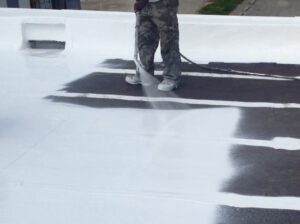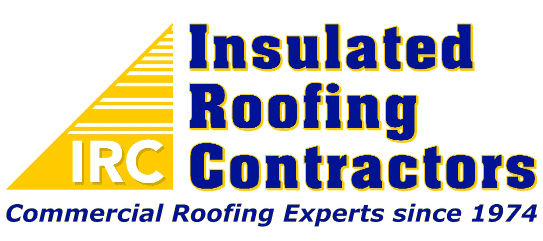There are some roofing systems that can be installed directly over top of the existing roof. A roof coating and a spray foam roof are two examples of retrofit roofing systems. As long as your existing roof is in good structural condition, a spray foam roof or roof coating can renew and restore your existing roof and avoid tear off and replacement.
STEPS IN THE RETROFIT ROOFING PROCESS
Replacing the flat roof on your building is no small task, and tear-off is a big factor that makes it difficult. There are options that allow you to avoid tearing your roof off though. Systems that are installed directly over your existing roof are called retrofit roofs and are a very effective, affordable roofing option. This post will examine the retrofit roofing process, how it differs from traditional roofing, and how it can benefit you.
An Important Distinction
Retrofit roofing can sound a lot like installing a new roof over your old one. However, there is a major difference between the two. The difference between installing a retrofit roof and installing a second, traditional roof above your existing roof is that retrofit systems aren’t counted as an additional roof in building codes, while installing a second roof is. This has implications on taxes and on tear-off in the future. Retrofit roofs do not require tear-off at the end of their lives, while a second roof does.

The Retrofit Roofing Process
There are two main retrofit systems, spray foam and restoration coatings. We install both and both are great systems, but we are a foam contractor first, so that is the system we will focus on here.
The first step in the process is a roof inspection for eligibility of the system and for safety concerns. Once it is determined that the roof is a good fit for foam and that the job can be done safely, it’s time to move on to the next step.
Making Necessary Repairs
The first major step of the retrofit roofing process is repairing the roof. This means anything that has worn down over the years will be repaired or replaced. These items are discovered in the initial inspection, marked down for repairs, and then repaired as the first step once the job begins.
Cleaning the Roof
Whether you’re installing a spray foam roof or a restoration coating for your retrofit project, cleaning the roof is an imperative part of your retrofit roofing process. Retrofit roofing projects require adhesion directly to the roof surface, and if it’s dirty, they won’t properly adhere. With bad adhesion, you could have a roof that begins to peel up. If the roof is clean, this is absolutely not a problem. But if you leave a thick layer of dirt and dust on the roof, there is nothing for the new material to “grab” onto.
Installing the New Material
Finally, you’ve got to install the new roof. The final step of your retrofit roofing process is actually several parts. If you want a detailed look at installing a spray foam roof or a silicone coating, check out some of our other posts. This post is a high-level look at the retrofit roofing process.
Whether it’s a coating or a spray foam roof, it will be spray-applied directly to the existing roof surface. The material is then allowed to cure. While the product is curing, granules are often added to the top layer of coating for added rigidity and non-slip surface.
A spray foam roof will consist of foam, a thin layer of protective coating, and usually a top layer of granules. A restoration coating will be one, maybe two layers of coating, with optional granules.
Maintenance and Recoating
Perhaps the greatest benefit of the retrofit roofing process is that maintenance is so easy on foam and restoration coatings, and that both can be renewed through recoating at the end of their lives.
For maintenance, all that’s usually need is a tube of caulk. Simply caulk over or fill in issues you find on your roof, and you’re done.
As for renewing at the end of these systems lives, that couldn’t be easier. They never really reach the end of their lives, just checkpoints, per say. After 20 years, apply a new, thin layer of restoration or protective coating, and that’s it. You get 20 more years of life out of the system, without ever having to tear-off your old roof. What a benefit!
Conclusion
This was a very high-level summary of the retrofit roofing process. We wanted to give you an overview of what the whole process looks like start to finish. If you have any questions or would like to learn more, give us a call.
Thanks for reading!
